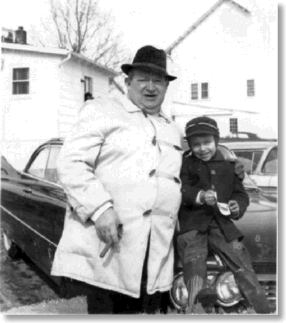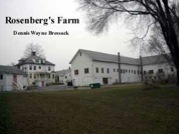
From the mid-1940's to the mid-1960's, holocaust survivors Albert and Kate Rosenberg and their son Gary, owned and operated a dairy farm in Orange County, New York. It was located two hours northwest of Manhattan on Route 302, in a tiny town called Bullville, about a quarter of a mile north of the Five Corners, where Route 302 intersects Route 17K. The traffic light at this intersection was, and still is, the only traffic light in town. This tiny village, held a few dozen small homes, several dairy farms with large farmhouses, two churches, Lunney's Service Station and Luncheonette, Tooties Service Station, Bullville Cattle Auction, Bullville Lake, Bell's Post Office and General Store, Agway Feed Store, Feebee's Bar and Grill, Bullville Creamery, Trempers ice cream factory and a small railroad station. Freight trains that passed through the town carried goods to and from Bullville, and transported milk and milk products from the local dairy farmers from the creamery and ice cream factory to neighboring towns.
Read More
.
Back at the Red Barn
Henderson's Old Barn
I've Got More Paper
Memory Parade
The Main House
Back at the Red Barn
Route 52 to Bullville snakes past Cragsmore’s peak
sneaks up the mountain’s bare bulging chest.
Winter’s bald crest with hair plug pine trees are
cognizant of the twisting stream slicing through the canyon below.
Snow sweats vanilla ice cream sculptures,
billowing down the perspiring borders of the boulders,
erecting stalagmite stalactite streamers
composed of unconscious crystals between dimensions.
The red paint of the debilitated barns peeled from the planks,
flaked in layers like skin off a leper.
The twisted, buckled boards were splintered, like fractured bone,
as if tornadoes tore down the walls and Godzilla stomped on the roof.
Metal airplane hanger pole barns have replaced red barns.
None of the dozen Bullville dairy farms has endured,
substituted by thoroughbred horse farms with million dollar fences and
pedigree communities pirouetting on very fertile land.
In these times of hay and honey for sale signs,
clairvoyant cows slosh, their hooves stuck in the slop of manure mud slush,
jaws rotating on feed, pursed nostrils comprehending karma,
making love to me with perceptive and contemplating eyes.
Henderson's Old Barn
Please don't build that schoolhouse
in the field next to Henderson's old barn.
Before the schoolhouse come
men to cut down trees,
tear up soil, pollute streams,
entomb wildlife within wood and brick coffins.
After the schoolhouse come
yellow school busses,
gas stations, school play traffic jams,
landfill for all their garbage.
After the schoolhouse come
plate glass malls with
Chinese Pizzerias, Bargain Basements,
Chapter 13 anchor stores.
After the schoolhouse come
Hideaway Springs Mountain Valley Danube Lullaby Estates
with shear, stark, hear through plaster walls,
a four by ten foot balcony view of the 18th hole,
a pool and playgrounds for the kids.
Have you heard enough yet?
Think about it while I get more paper.
I've Got More Paper
On the road to Bullville
through imaginary tunnels
of stone walls and tall trees,
I revisited Henderson’s old barn.
The barn was torn down.
The red wood was sold.
A concrete slab, rusted stove,
River Lane Antiques sign remained.
Thirty years ago,
the farmer sold the fields.
Schools were built,
malls constructed,
condos fabricated.
From calm of cornfields
came chaos of development.
Now, in downtown Middletown,
there are trendy shops,
vacant buildings and empty lots.
“Vermin” from the city
roam the streets,
once safe enough for eight year-old boys
to hop the bus in Bullville,
to see Elvis in “King Creole” at the Paramount.
Memory Parade
Chickens, cows, humans, machines and God.
This organized chaos is the epicenter of life.
My memory marches, parades into synapses
of silken summers surrounded by surreal sense dances.
In the midst of a hundred-head fragrance factory farm,
flies as thick as black snow squalls
whirl around a plethora of piles of piquant cow dung and
lemon-tart tangy essences of spicy silo corn.
When whiffed, this squooshed sweet and sour smell
snaps my sinus lining inside out,
slaps, then clicks my olfactory hairs to attention.
Subsequent to thunderous torrents of boiling rain,
camouflaged candlesticks of orange salamanders slip, slither, slide
from under overturned decayed cicada cages of forest floor rocks.
Restless on my wrist,
newts parachute, plummet and wiggle-whip
beneath a bouquet of rotting leaves.
Sensory spectacles at dusk,
the clamorous Catskill,
melodious mountain cricket drone,
deep, dark, exploding sky spilling
millions of fluorescent fireflies
that light my way.
The Main House
Five dollars a day for adults,
three bucks for cantankerous children.
The clinkclankclunk of the cowbell’s tongue tolled the ritual of three
family-style belly-busting meals in a dining room set for forty.
The three-story farmhouse was fabricated
from squeaky, creaky wood and glacier-shaped stone.
A rustic, country kitchen with a walk-in fridge
was filled with black, orange and purple soda bottles.
For a nickel, crank machines with glass turbans vended
a variable hand-full of red pistachio nuts and multicolored M&M’s.
Red dye tattoos on your fingertips, chocolate blotches on your cheek
were donned as sweet and salty badges of honor.
Twelve guest rooms with flowered wallpaper,
three bathrooms, black and white tiled floors,
porcelain sinks with separate hot and cold faucets and
a white clawed-foot tub with a rubber stop on a chain.
Heavy oak sliding French doors led into the parlor with
red, shiny, fluffy, satin-fringed brocade couches and chairs.
Teenage girls called me cute, tussled and combed my hair
as a charming grandfather clock sublimely chimed.
Every step on the long staircase squawked
in the dialect of nails rubbing inside wooden cell tombs.
Dervishly sliding down the oak-stained banister,
children wrapped their loins around heaven’s womb.
